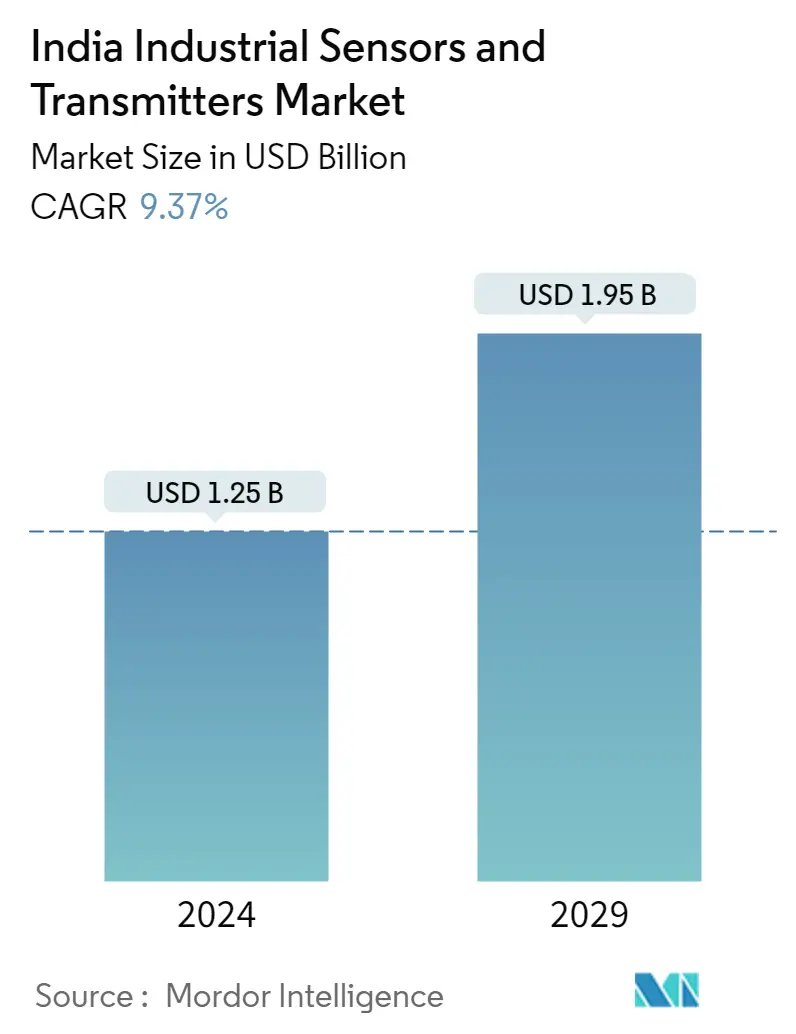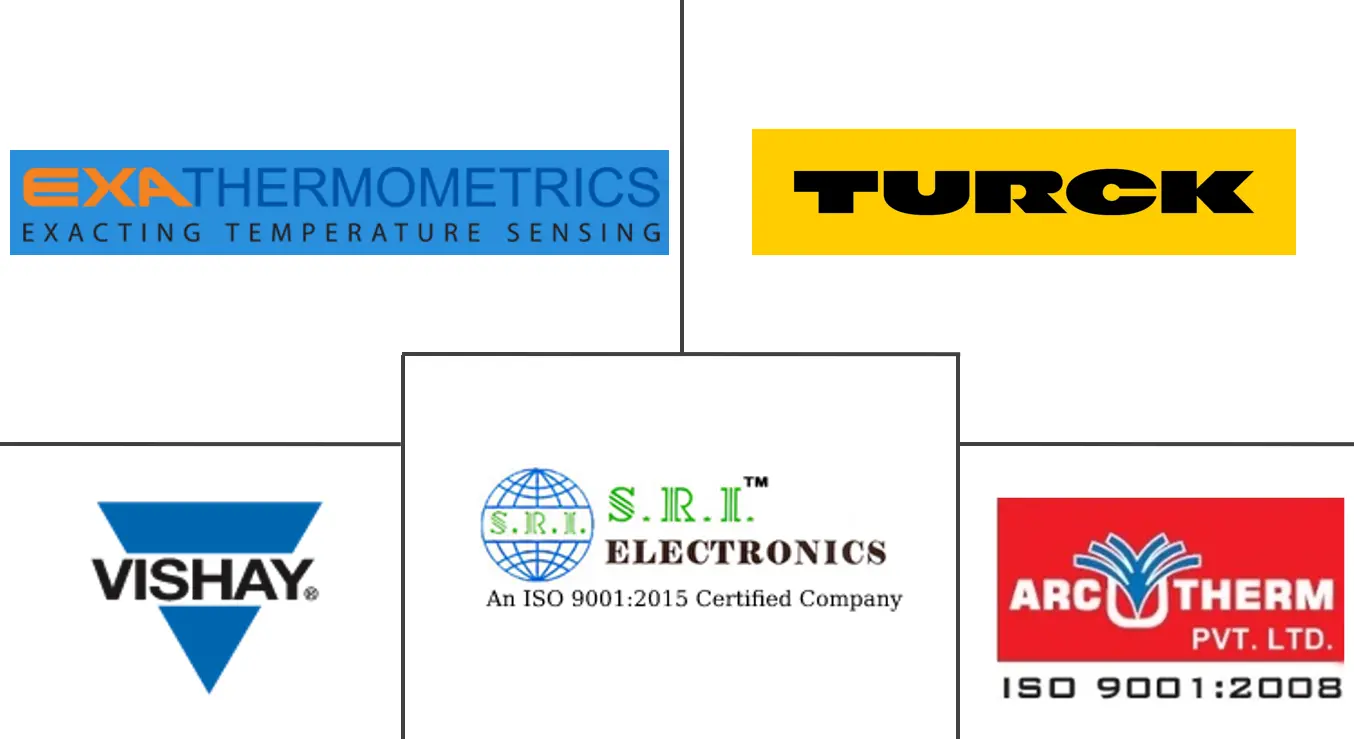Market Size of India Industrial Sensors and Transmitters Industry

| Study Period | 2019 - 2029 |
| Base Year For Estimation | 2023 |
| Market Size (2024) | USD 1.25 Billion |
| Market Size (2029) | USD 1.95 Billion |
| CAGR (2024 - 2029) | 9.37 % |
| Market Concentration | High |
Major Players
*Disclaimer: Major Players sorted in no particular order |
India Industrial Sensors & Transmitters Market Analysis
The India Industrial Sensors and Transmitters Market size is estimated at USD 1.25 billion in 2024, and is expected to reach USD 1.95 billion by 2029, growing at a CAGR of 9.37% during the forecast period (2024-2029).
- Factory automation and Industry 4.0 rely heavily on industrial sensors. Sensors such as motion, environmental, and vibration sensors are used to monitor the health of equipment, ranging from linear or angular positioning to tilt sensing, leveling, shock, or fall detection. India's industries are well-positioned to expand their operations economically and demographically while supporting domestic interests and export opportunities that are expected to increase soon.
- As part of the 'Make in India' initiative, the Indian government intends to prioritize automobile manufacturing. According to the Auto Mission Plan (AMP) 2016-26, the passenger car market would triple to 9.4 million units by 2026, which is predicted to increase sensor usage in the region. Companies are also expanding their activities to strengthen their positions in the markets in which they operate. For example, Gurgaon-based auto component supplier Minda Industries partnered with two Chinese subsidiaries of US-based Sensata to purchase the wheel speed sensors required to enhance their portfolio.
- Furthermore, the demand for automation is expanding in government-designated essential industries such as food and beverage, manufacturing, and pharmaceutical, due to a lack of labor and the need for remote monitoring and working, which has driven the demand for various sensors.
- Cost and operational concerns are some of India's barriers to market growth. High installation costs may cause disinclination in the adoption of sensor technology. The sensor's specifications vary depending on the application, and the price of the sensors is determined by the quality of raw materials used. For example, as an important part of producing a superior temperature sensor, the producer's high-quality raw materials choice is vital.
- COVID-19 had a negative impact on many industrial sectors. The automotive and process industries were on hold or reduced production during the first quarter of 2020. As a result, the demand for all types of sensors in these industries was significantly impacted. Expansion of industrial and IoT devices for pressure sensors was observed as more and more process industries started investing in automation monitoring devices, owing to safety and stringent government regulations in India.
India Industrial Sensors & Transmitters Industry Segmentation
Industrial sensors are devices that can detect events or changes in the environment and provide the corresponding output. The study of the scope included various types of sensors and transmitters that are used for industrial automation purposes across multiple end-user industries in India.
India Industrial Sensors and Transmitters Market is segmented by Type of Sensor (Flow, Temperature, Pressure, Level, Transmitters) and by End-user (Power, Petrochemicals, Chemicals and Fertilizers, Food and Beverage, Water and Wastewater, Life Sciences, Oil and Gas).
| Type of Sensor | |
| Flow | |
| Temperature | |
| Pressure | |
| Level | |
| Transmitters and Other Sensors |
| End-User | |
| Power | |
| Petrochemicals, Chemicals and Fertilizers | |
| Food and Beverage | |
| Water and Wastewater | |
| Life Sciences | |
| Oil and Gas | |
| Other End-Users |
India Industrial Sensors and Transmitters Market Size Summary
The India Industrial Sensors and Transmitters Market is poised for significant growth, driven by the increasing adoption of factory automation and Industry 4.0 initiatives. These sensors, including motion, environmental, and vibration sensors, play a crucial role in monitoring equipment health and enhancing operational efficiency. The Indian government's 'Make in India' initiative, particularly in the automobile sector, is expected to boost sensor demand as the automotive market expands. Additionally, the need for automation in essential industries such as food and beverage, manufacturing, and pharmaceuticals is rising due to labor shortages and the necessity for remote monitoring. However, high installation costs and varying sensor specifications pose challenges to market growth. The COVID-19 pandemic initially disrupted sensor demand in sectors like automotive and process industries, but it also spurred investments in industrial IoT devices for safety and compliance.
The market is characterized by the widespread use of flow and pressure sensors across various industries, including oil and gas, chemicals, and pharmaceuticals. Flow sensors, utilizing technologies like Coriolis and Ultrasonic, are essential for measuring fluid flow in harsh environments, while pressure sensors are critical for automatic control in chemical processes. The adoption of these sensors is further driven by stringent regulations and the need for efficiency in operations. The market is concentrated with a few key players who are focusing on strategic mergers, acquisitions, and innovation to maintain a competitive edge. Recent developments, such as the establishment of a Centre of Excellence in Intelligent IoT sensors and the introduction of advanced sensor modules, highlight the ongoing efforts to enhance sensor technology and its applications in India.
India Industrial Sensors and Transmitters Market Size - Table of Contents
-
1. MARKET INSIGHTS
-
1.1 Market Overview
-
1.2 Value Chain Analysis
-
1.3 Industry Attractiveness- Porter's Five Forces Analysis
-
1.3.1 Threat of New Entrants
-
1.3.2 Bargaining Power of Buyers
-
1.3.3 Bargaining Power of Suppliers
-
1.3.4 Threat of Substitutes
-
1.3.5 Intensity of Competitive Rivalry
-
-
1.4 Technology Snapshot
-
1.5 Assessment of the Impact of COVID-19 on the Market
-
-
2. MARKET SEGMENTATION
-
2.1 Type of Sensor
-
2.1.1 Flow
-
2.1.2 Temperature
-
2.1.3 Pressure
-
2.1.4 Level
-
2.1.5 Transmitters and Other Sensors
-
-
2.2 End-User
-
2.2.1 Power
-
2.2.2 Petrochemicals, Chemicals and Fertilizers
-
2.2.3 Food and Beverage
-
2.2.4 Water and Wastewater
-
2.2.5 Life Sciences
-
2.2.6 Oil and Gas
-
2.2.7 Other End-Users
-
-
India Industrial Sensors and Transmitters Market Size FAQs
How big is the India Industrial Sensors and Transmitters Market?
The India Industrial Sensors and Transmitters Market size is expected to reach USD 1.25 billion in 2024 and grow at a CAGR of 9.37% to reach USD 1.95 billion by 2029.
What is the current India Industrial Sensors and Transmitters Market size?
In 2024, the India Industrial Sensors and Transmitters Market size is expected to reach USD 1.25 billion.

